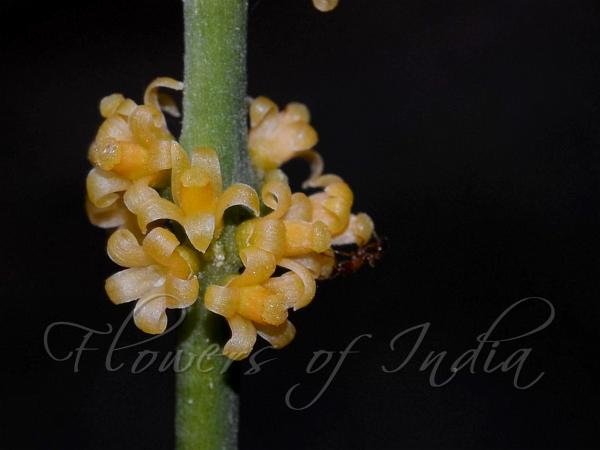|
| Ingudi |
|

|

|
|
|
|
Photo: |
Botanical name: Sarcostigma kleinii Family: Icacinaceae (Unicorn Plant family)
Synonyms: Sarcostigma horsfieldii, Sarcostigma wallichii
Synonyms: Sarcostigma horsfieldii, Sarcostigma wallichii
Ingudi is a woody climber with branchlets hairless.
Leaves are 17-22 x 8-12 cm, oblong-lanceshaped, tip tapering, base
rounded or blunt; lateral nerves 8 pairs, netveined; leaf-stalk 5-12 cm
long. Flowers are borne in spikes up to 35 cm long, slender, in
leaf-axils or from tubercles. Flowers are 3-6 together, yellow; calyx
cup-shaped, 2 mm across, 5-toothed; petals 3-5 mm long, oblong,
recurved; stamens 5, anthers versatile, staminodes 5; female flowers
mostly from old wood, ovary 1-celled, densely hairy; stigma stalkless,
discoid; pistillode in male flowers conical. Drupe to 3 x 1.5 cm,
ovoid, orange-yellow, hairless. Ingudi is found in Indo-Malesia.
Medicinal uses: Fruits are eaten and also used
in rheumatism. Seeds yield fatty oil which is esteemed as a cure for
rheumatism, but is reported to be injurious to eyes. Powdered bark
mixed with honey is given in rheumatism, leprosy, hysterics and ulcers.
The bark and leaves are boiled in oil for application in rheumatism.
Fruits are eaten and also used
in rheumatism. Seeds yield fatty oil which is esteemed as a cure for
rheumatism, but is reported to be injurious to eyes. Powdered bark
mixed with honey is given in rheumatism, leprosy, hysterics and ulcers.
The bark and leaves are boiled in oil for application in rheumatism.
Medicinal uses:
 Fruits are eaten and also used
in rheumatism. Seeds yield fatty oil which is esteemed as a cure for
rheumatism, but is reported to be injurious to eyes. Powdered bark
mixed with honey is given in rheumatism, leprosy, hysterics and ulcers.
The bark and leaves are boiled in oil for application in rheumatism.
Fruits are eaten and also used
in rheumatism. Seeds yield fatty oil which is esteemed as a cure for
rheumatism, but is reported to be injurious to eyes. Powdered bark
mixed with honey is given in rheumatism, leprosy, hysterics and ulcers.
The bark and leaves are boiled in oil for application in rheumatism.
| Identification credit: Shrikant Ingalhalikar | Photographed in Agumbe & Anshi, Karnataka. |
• Is this flower misidentified? If yes,